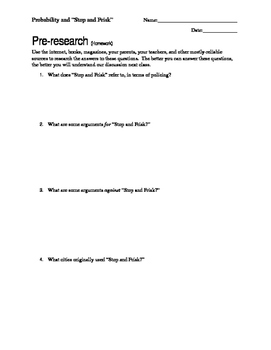Using Probability to Teach Social Justice
Weapon of Math Instruction
10 Followers
Grade Levels
8th - 12th
Subjects
Resource Type
Standards
CCSSHSS-IC.A.1
CCSSHSS-IC.A.2
CCSSHSS-IC.B.4
CCSSHSS-IC.B.5
CCSSHSS-CP.A.2
Formats Included
- Word Document File
Pages
7 pages
Weapon of Math Instruction
10 Followers
Description
This is an exploratory experiment/activity about basic probability. Students discover the differences between theoretical probability, experimental probability, and reality by taking a hard look at Stop and Frisk in urban areas. Students also deal with independent and dependent events.
By the end of the project, students will be able to:
Articulate the differences between theoretical and experimental probability through prediction and experimentation.
Articulate the differences between independent and dependent events.
Analyze the morality of social issues through comparing and contrasting 3 different sets of data (theoretical, experimental, and real life percentages).
Construct an argument in support or opposition of social issues using statistics.
*Project spirals in percentage calculation as well.
The detailed answer key can be downloaded separately.
By the end of the project, students will be able to:
Articulate the differences between theoretical and experimental probability through prediction and experimentation.
Articulate the differences between independent and dependent events.
Analyze the morality of social issues through comparing and contrasting 3 different sets of data (theoretical, experimental, and real life percentages).
Construct an argument in support or opposition of social issues using statistics.
*Project spirals in percentage calculation as well.
The detailed answer key can be downloaded separately.
Total Pages
7 pages
Answer Key
Not Included
Teaching Duration
2 hours
Report this resource to TPT
Reported resources will be reviewed by our team. Report this resource to let us know if this resource violates TPT’s content guidelines.
Standards
to see state-specific standards (only available in the US).
CCSSHSS-IC.A.1
Understand statistics as a process for making inferences about population parameters based on a random sample from that population.
CCSSHSS-IC.A.2
Decide if a specified model is consistent with results from a given data-generating process, e.g., using simulation. For example, a model says a spinning coin falls heads up with probability 0.5. Would a result of 5 tails in a row cause you to question the model?
CCSSHSS-IC.B.4
Use data from a sample survey to estimate a population mean or proportion; develop a margin of error through the use of simulation models for random sampling.
CCSSHSS-IC.B.5
Use data from a randomized experiment to compare two treatments; use simulations to decide if differences between parameters are significant.
CCSSHSS-CP.A.2
Understand that two events 𝘈 and 𝘉 are independent if the probability of 𝘈 and 𝘉 occurring together is the product of their probabilities, and use this characterization to determine if they are independent.





